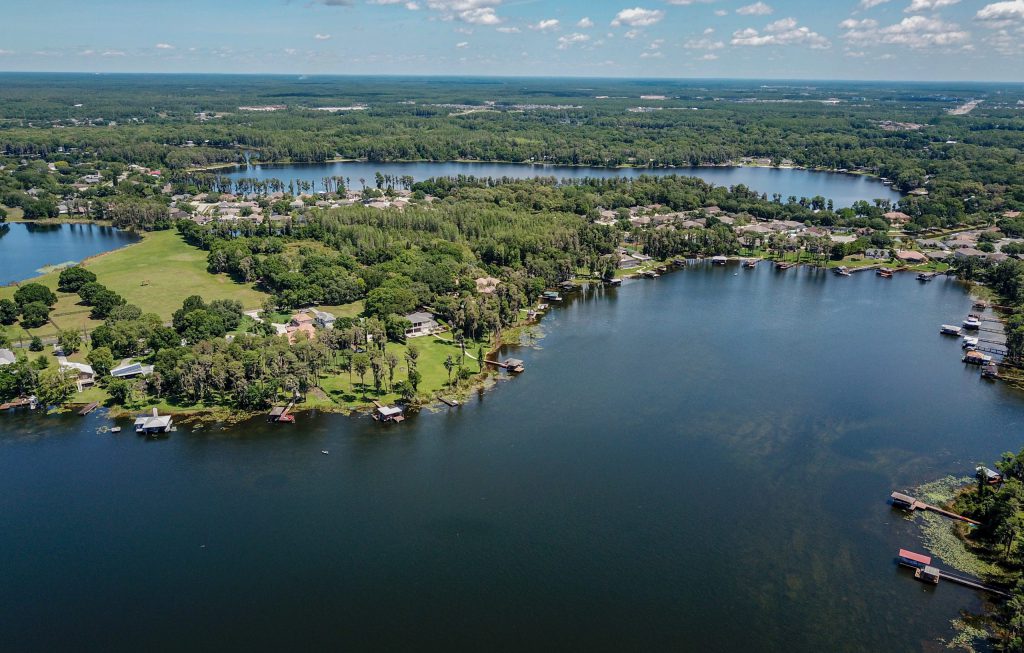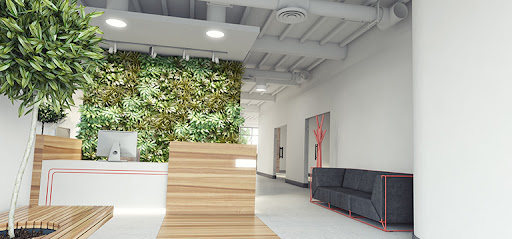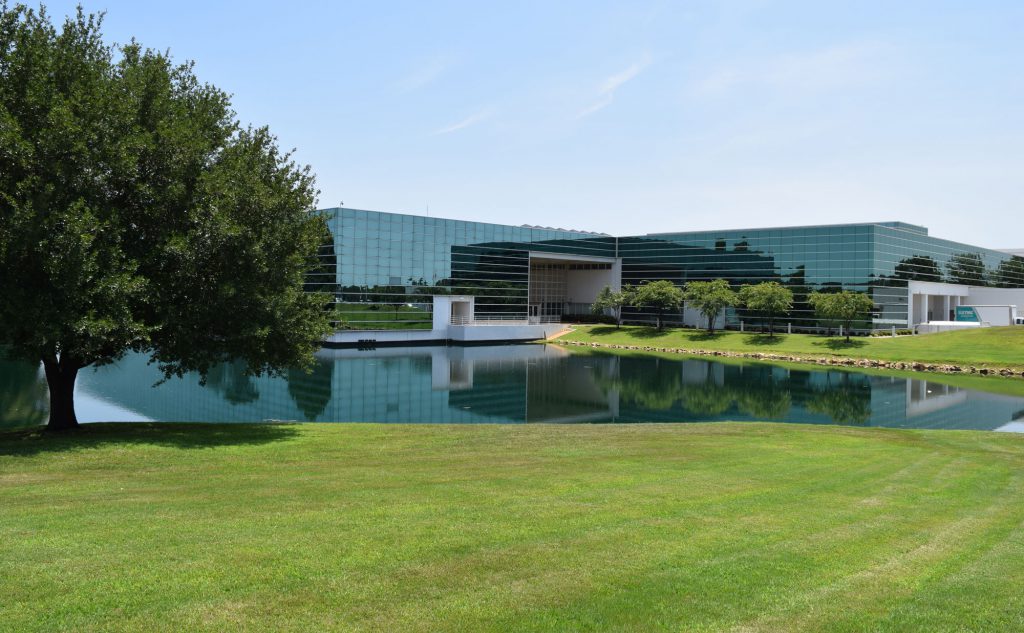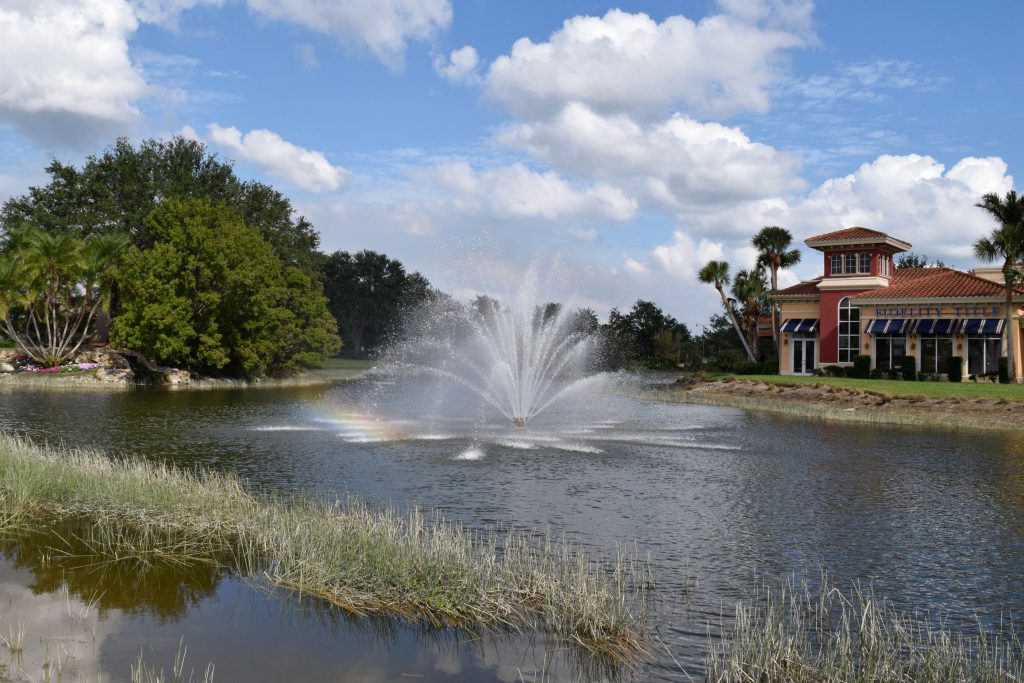
Lakes and leaves: the calming allure of the natural world
Pretend for a moment that you are asked to draw Planet Earth. You have a blank piece of paper and a full set of crayons containing every color you could imagine sitting in front of you. Which colors do you reach for first? Anyone who has taken an elementary school science class would likely say blue and green. Blue for the waters — accounting for 71% of the earth’s surface, and green to represent the land — an enduring component of life since the beginning of time. Maybe not so surprisingly, these two colors are also at the forefront of our inherent connection to nature. Here, we explore the power of both — blue, representing water and its impact on our well-being and green, representing the natural world as a whole.
At SOLitude, our mission is to preserve and protect ecological balance, which we do by providing our clients with superior value and expertise in lake, stormwater pond, wetland and fisheries management. In fact, the very idea for SOLitude Lake Management was rooted in a love for water and the outdoors. With similar nature-based philosophies at our cores, SOLitude and our sister company, Ambius, strive to create healthier and more beautiful spaces indoors and out.
To learn more about our solutions and how we can help you reach your goals, contact us today.

The Psychology of Color
Green and blue are both colors with shorter wavelengths, characterized as “relaxing or cool.”² While both colors have some negative connotations, (think “having the blues” or “feeling a little green”) they similarly remind us of nature and thus have a calming effect. Just looking at colors with short wavelengths, such as green and blue, is less taxing to the eyes than looking at a color like red, as it requires less retinal adjustment.⁴
Dr. Wallace J. Nichols tells the story of a quarry pool in Harpur Hill with turquoise water. Despite its beautiful color, the water was filled with dead animals and garbage and had a pH level similar to that of ammonia. Signs were posted warning visitors that swimming there could cause skin and eye irritations, fungal infections, and stomach problems, but that did not stop people from taking a swim — enchanted by the color. The local government finally intervened, dying the pool black. Without the mesmerizing turquoise hue, people were much less inclined to swim in the water.
As humans, we are drawn to these shades. Dr. Amir Vokshoor, a neurosurgeon specializing in minimalistic brain and spine surgery, theorizes that the positive feelings and emotions humans have in response to blues and greens are the by-products of human evolution in the natural world. Humans have evolved in amongst the blue shades of water and sky and the green tones of the earth.¹ The inherent familiarity brings us comfort.

What is “Blue Mind”?
As defined by Wallace J. Nichols, Ph.D., author of Blue Mind, it is “a mildly meditative state characterized by calm, peacefulness, unity, and a sense of general happiness and satisfaction with life in the moment…inspired by water and elements associated with water.”¹ In addition to livelihood dependencies, an effect such as this illustrates why an estimated 80% of the world’s population lives within sixty miles of a waterbody coastline. Humans have an innate desire to be near water.
Blue Mind is in direct contrast to “Red Mind,” a state described by neuroscientist Catherine Franssen, Ph.D. as an “edgy high, characterized by stress, anxiety, fear, and maybe even a little bit of anger and despair.” At one point in evolution, the “Red Mind” hormones were essential for survival — from fighting for food or a mate to quite literally running for your life (away from predators). But today, we’re able to activate these same systems with less life-threatening stressors. “The same physiological stress response that we use[d] to run away from a lion on the Serengeti is activated when the mortgage bill shows up in the mail.”¹ With everyday stressors having this intense effect on our bodies, we need methods and practices that can help regulate. That’s where the concepts of “Blue Mind” and biophilic design come into play.

Ways to Trigger the “Blue Mind” Effect
In his book, Dr. Nichols offers some methods one can use to trigger the “Blue Mind” effect.
- Go swimming – Perhaps the most obvious on the list, take a dip in a swimming pool or natural body of water. Not only are you immersing yourself in water, but you’re stimulating endorphin and endocannabinoid release by taking part in an aerobic exercise. By releasing these natural painkillers (endorphins and endocannabinoids), the stress and anxiety response in your brain is reduced.
- Learn to surf – If you’re the adventurous type, you could pick up a new hobby like learning to surf. This is a popular choice for those recovering from addiction because high-intensity sports such as surfing satisfy the “rush” that they crave.
- Go fishing – For those who enjoy fishing, it can be simultaneously quite relaxing while providing a distraction from life’s stressors.
- Visit an aquarium – This is an option that allows you the opportunity to enjoy underwater life without partaking in a strenuous activity such as scuba diving. Studies have shown substantial drops in blood pressure and heart rate in people who viewed aquarium tanks, especially those with a great deal of biodiversity.
- Take a bath – Here’s another, possibly more relaxing, way to immerse yourself in water. Doing so helps to balance your sympathetic and parasympathetic nervous systems, promoting relaxation.
- Drink water – Yes, you read correctly. Simply drinking water can help you achieve the “Blue Mind” effect. Dehydration can have many negative effects on the body including lowered alertness, decreased psychomotor and regulatory functions, and even increased anxiety. If you’re feeling a little “off,” try grabbing a glass of water.
- Get a fountain – Last but not least, we have the addition of a fountain. The sight and sound of the water can help you achieve a meditative state, allowing you to relax and rejuvenate. While there are small fountains that can be placed on desks or tables, large, outdoor fountains achieve the meditative effect on a grander scale, allowing many to enjoy them all at once. As an added benefit, floating fountains and other oxygen saturation technologies can improve the health of the waterbody, too, by eliminating toxins, improving water clarity and more.
Certainly, not all of these options are viable in controlled environments such as workplaces or healthcare facilities, but they do illustrate the power of water as it pertains to our health and well-being.

What is “biophilia”?
When you take the concept of the “Blue Mind” and expand it to encompass all forms of nature, you enter the territory of biophilia. In fact, one might even think of the “Blue Mind” as a part of biophilia. Water is a fundamental natural element, and as humans, we are drawn not just to it, but to nature as a whole.
Edward O. Wilson, the “father of biophilia”, defined it as “the innate affiliation people seek with other organisms and especially the natural world.” Scholars believe that this ingrained attachment stems from the early days of humankind. Our ancestors relied on the natural environment for survival and though we’ve evolved significantly since those days, we’ve maintained the need for that connection.
Ambius completed a research study in which they discovered that the average office worker spends about 47 minutes outdoors during the workday — less than the daily amount mandated for prisoners according to U.N. guidelines. With that much time spent indoors, it is imperative that people have supplemental access to nature.
Luckily, studies have found that you don’t necessarily have to be outside in the midst of nature to reap its benefits. “The sense of connection you have with the natural world seems to contribute to happiness even when you’re not physically immersed in nature,” says Lisa Nisbet, Ph.D.³
Exposure to nature, even if just through indoor plants, green walls, or a view of an outdoor water feature has been linked to a host of benefits.
- Lower stress
- Improved attention and memory
- Greater cooperation
- Better mood
- Increased productivity
With this in mind, we can reshape how we think about and interact with our environments.
The Impact of A Water Feature
Proximity to water is one of the essential components of biophilic design. Water features not only provide an aesthetically pleasing focal point but elevate the value and perception of a property. Adding water creates a tranquil environment that promotes reduced stress along with improved concentration and memory, all while promoting sustainability. Water features actually lose less water to evaporation than a lawn or garden of the same size.⁵
There’s a predictability in water. Though it’s ever-changing, it appears steady. Nichols says, “In the motion of the water we see patterns that never exactly repeat themselves yet have a restful similarity to them.”¹ Because of this, our brain is able to relax. He goes on to say that despite the consistency of water, we keep searching for something that wasn’t there before — a change. When we do see something “out of the ordinary,” such as a wave or other disturbance, something in our brain is pleasantly surprised and releases dopamine. This dichotomy allows us to experience both “soothing familiarity and stimulating novelty” at the same time.
Thinking about adding a water feature to your property? In addition to traditional aeration solutions like floating fountains and submersed aerators, SOLitude Lake Management designs, constructs, and maintains architectural fountains and custom water features. SOLitude experts will help you design a solution that fits your needs and is customized for your space. Our knowledgeable team has an eye for aesthetics and can recommend styles that align well with your property type, budget, and long-term goals.

Biophilia and the “Blue Mind”
The striking benefits of exposure to nature – especially water – expand far beyond the walls of the workplace. Ongoing research has shown a reduction in pain and in recovery times in patients who had some sort of nature connection, whether that be ample natural light, a plant in their room, or even just artwork depicting a natural scene. One such study by Roger S. Ulrich, Ph.D., Director of the Center for Health Systems and Design at Texas A&M University, found that heart surgery patients experienced less anxiety and need for pain medication when given the opportunity to look at pictures of trees and water.⁶
We could all use a little more exposure to nature and all of its elements, especially water. Your customers, tenants, guests, employees, and operations writ large only stand to benefit from bringing the natural world a little closer.
To learn more about SOLitude’s sustainable solutions for improving water quality, enhancing beauty, preserving natural resources and reducing your environmental footprint, contact us today. And to discover how biophilic design can transform your indoor environment, consider a partnership with our sister company Ambius, the experts in creating smarter, healthier spaces.
Enhance Your Aquatic Spaces for All To Enjoy
¹Nichols, W. J., & Cousteau, C. (2015). Blue mind: The surprising science that shows how being near, in, on, or under water can make you happier, healthier, more connected and better at what you do. Back Bay Books/Little, Brown and Company.
²Elliot AJ. Color and psychological functioning: A review of theoretical and empirical work. Front Psychol. 2015;6. doi:10.3389/fpsyg.2015.00368
³American Psychological Association. (2020, April). Nurtured by nature. Monitor on Psychology, 51(3). https://www.apa.org/monitor/2020/04/nurtured-nature
⁴Kurt, S., & Osueke, K. K. (2014). The Effects of Color on the Moods of College Students. SAGE Open. https://doi.org/10.1177/2158244014525423
⁵Roy, C. (2021, July 20). The magic of water features in a post-COVID world. Buildings. https://www.buildings.com/articles/43005/water-features-post-covid
SOLitude Lake Management is a nationwide environmental firm committed to providing sustainable solutions that improve water quality, enhance beauty and preserve natural resources.
SOLitude’s team of aquatic scientists specializes in the development and execution of customized lake, stormwater pond, wetland and fisheries management programs. Services include water quality testing and restoration, algae and aquatic weed control, installation and maintenance of fountains and aeration systems, shoreline erosion control, muck and sediment removal and invasive species management. SOLitude partners with homeowners associations, golf courses, private landowners, businesses and municipalities. SOLitude Lake Management is part of Rentokil, a leading business services company, operating across the United States, Canada and Puerto Rico.
For more information, visit SOLitude Lake Management at solitudelakemanagement.com, and connect on Facebook, LinkedIn and Twitter.
⁶Clay, R. A. (2001, April). Green is good for you. Monitor on Psychology, 32(4). https://www.apa.org/monitor/apr01/greengood










